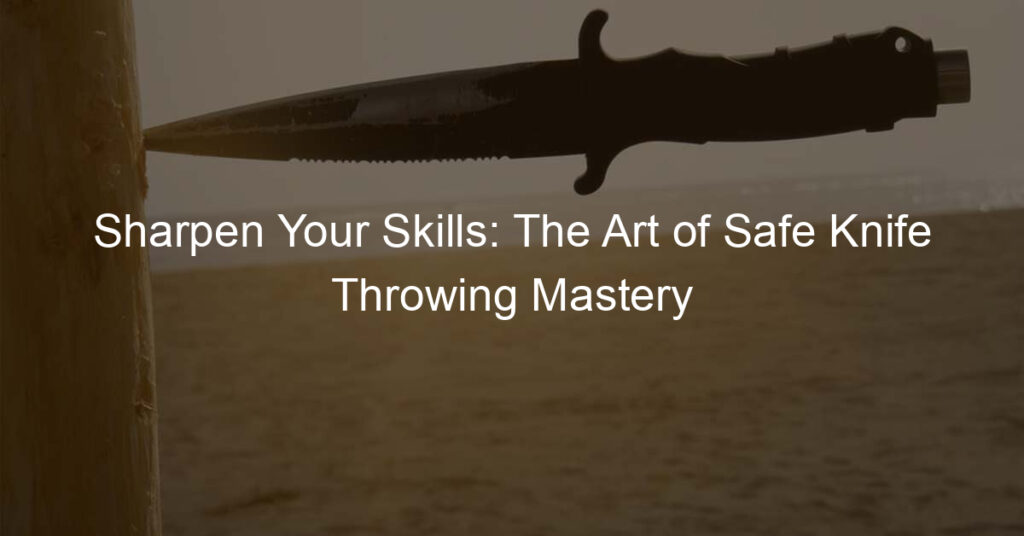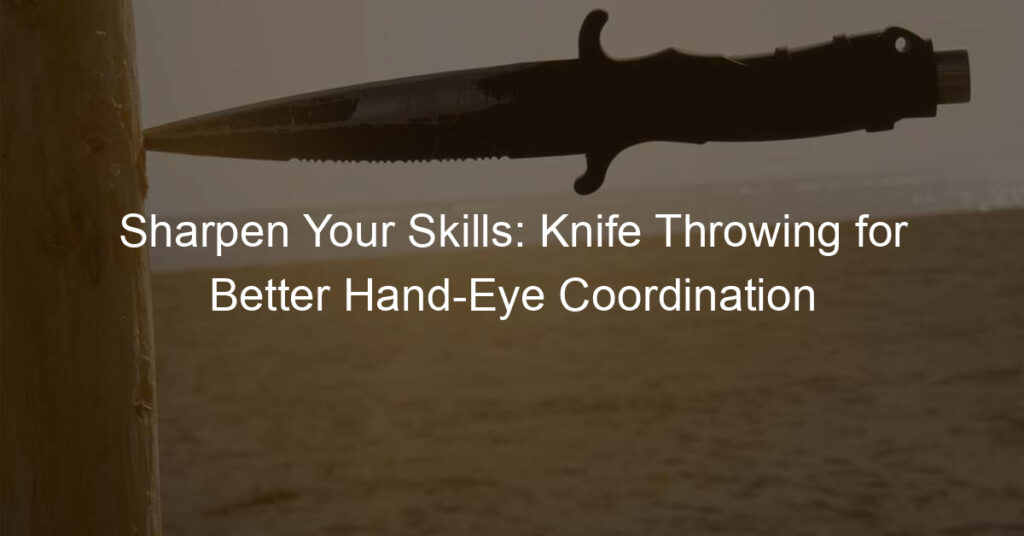Introduction to Knife Throwing
It requires precision, focus, and a deep understanding of the basics. In this article, we will delve into the world of knife throwing, exploring its history and evolution, and understanding the fundamental principles that govern this unique art.
-
- The basics of knife throwing
At its core, knife throwing involves propelling a knife, typically specially designed for this purpose, so that it rotates in the air, landing point-first into a target. This requires a keen understanding of the knife’s balance, the distance to the target, and the force required to make a successful throw. It’s a delicate balance of physics and finesse.
-
- Exploring the history and evolution of knife throwing
Used by indigenous tribes and ancient civilizations. Over time, it evolved into a sport and a form of entertainment, with competitions held globally.
From the throwing knives used by African tribes to the Kunai thrown by Japanese ninjas, the art of knife throwing has taken many forms. Today, it is a regulated sport with standardized equipment and scoring systems, but the thrill and excitement of the throw remain unchanged.
Whether you’re a beginner looking to take up a new hobby or an experienced thrower seeking to refine your technique, understanding the basics and history of knife throwing can enhance your appreciation for this exciting sport.
Knife Throwing for Beginners
Knife Throwing Techniques
-
- Understanding the Grip
The way you hold the knife determines its trajectory and rotation. For beginners, the hammer grip—holding the knife handle as if you’re holding a hammer—is recommended. This grip provides control and stability, making it easier for beginners to learn the basics of knife throwing.
-
- Mastering the Stance
Stand with one foot forward—right foot if you’re right-handed, left foot if you’re left-handed. Your body should be straight, and your weight evenly distributed. This stance provides balance and allows for a smooth, controlled throw.
-
- Perfecting the Throw
A good throw requires a smooth release and a straight arm swing. The power of the throw comes from your arm and wrist, not your body. Practice is key to perfecting your throw. Start with short distances and gradually increase as you become more comfortable and accurate.
Safety Measures in Knife Throwing
-
- Importance of Safety in Knife Throwing
Involves handling sharp objects, which can lead to injuries if not done correctly. Safety measures are crucial to prevent accidents and ensure a fun and enjoyable experience. It’s not just about hitting the target; it’s also about doing it safely.
-
- Basic Knife Throwing Safety Rules
Always handle the knives with care. Never throw a knife towards another person. Ensure your target is sturdy and secure. Fourth, always check the area behind your target. Never try to catch a bouncing knife. Following these rules will help keep you and others safe.
-
- Choosing the Right Environment for Practice
The area should be spacious and free from obstructions. It should also be far from people and pets to avoid accidental injuries. An outdoor space with a solid and secure target is ideal.
Advanced Knife Throwing Techniques
-
- Mastering the Spin Throw
It involves throwing the knife in a way that it spins in the air before hitting the target. The key to mastering this technique is understanding the rotation of the knife and adjusting your throw accordingly. Practice makes perfect, so don’t be discouraged if you don’t get it right away.
-
- Understanding the No-Spin Throw
As the name suggests, the knife does not spin in this technique. Instead, it flies straight towards the target. This requires a firm grip and a precise release. It might take some time to get the hang of it, but once you do, it can be a very effective technique. Always ensure you’re practicing in a safe environment.
-
- Practicing the Half-Spin Throw
The knife makes a half rotation before hitting the target. This technique can be tricky to master, but it’s a great skill to have in your arsenal. As always, make sure you’re practicing safely.
Enhanced Safety Measures
-
- Advanced Knife Throwing Safety Tips
-
-
- Always check the area around you before you throw. Make sure no one is in your throwing path.
- Use a knife designed for throwing. These knives are balanced and designed to be thrown safely.
- Never throw a knife when you’re angry or upset. Emotions can affect your judgment and lead to accidents.
- Safe Knife Throwing Practices
- Always throw at a designated target. Never throw at living things or personal property.
- Keep your throwing area clean and free of obstacles. A cluttered area can lead to accidents.
- Never try to catch a bouncing or rebounding knife. Step back and let it fall to the ground.
- Dealing with Common Knife Throwing Injuries
- For minor cuts, clean the wound with warm water and soap, apply an antibiotic ointment, and cover it with a clean bandage.
- For more serious injuries, seek medical attention immediately. Don’t try to treat a deep cut or puncture wound on your own.
- Always have a first aid kit nearby when you’re throwing knives. It should include bandages, antiseptic wipes, and tweezers.
-
Knife Throwing Training
Self Training Vs Professional Training
-
- Benefits of professional knife throwing training
Instructors can correct your form, technique, and safety habits, which can be invaluable for beginners. According to a study by the International Knife Throwers Hall of Fame, beginners who received professional training were 75% less likely to develop bad habits or injure themselves compared to those who self-trained.
-
- How to practice knife throwing at home safely
Always practice in a clear, open space away from people and pets. Use a sturdy target made of soft wood and ensure your knives are sharp and well-maintained. Never throw a knife towards another person or throw it in a way that it could bounce back towards you.
Choosing the Right Equipment
The knife should be balanced, with the center of gravity in the middle. It should also be heavy enough to ensure a stable flight but light enough to handle comfortably. The length of the knife should be between 12 to 16 inches. A good example is the throwing knife which is designed specifically for this purpose.
-
- Knife Throwing Equipment Safety
Always ensure your throwing area is clear of people and pets. The target should be placed against a safe backdrop to prevent any ricochets. Always handle the knife by the handle and not the blade. Regularly inspect your equipment for any damages or defects that could cause accidents.
-
- Maintaining Your Knife Throwing Equipment
Regularly clean your knives to prevent rust and ensure they are sharp enough for a good throw. Store your knives in a dry place to prevent moisture damage. Regularly inspect your target for wear and tear and replace it when necessary.
Professional Knife Throwing
Competing in Knife Throwing
-
- Understanding the rules of professional knife throwing
These rules govern the type of knives used, the distance from the target, and the scoring system. For instance, the International Knife Throwers Hall of Fame (IKTHOF) stipulates that the knife must be thrown from a minimum distance of 12 feet for it to count. Understanding these rules is crucial for anyone aspiring to compete professionally.
-
- Preparing for a knife throwing competition
You need to practice your throwing techniques regularly to improve your accuracy and consistency. Mentally, you need to build your focus and learn to handle the pressure of competition. Familiarize yourself with the competition venue and equipment beforehand. This will help you feel more comfortable and confident during the actual competition.
Building a Career in Knife Throwing
-
- Opportunities in Professional Knife Throwing
You can compete in local, national, and international competitions. Some knife throwers even perform in circuses, magic shows, or as part of a stunt team in movies. There are several professional knife throwing organizations worldwide that offer membership, training, and competition opportunities.
-
- Building Your Skills and Reputation
Start by practicing regularly and learning from experienced throwers. Participate in local competitions to gain exposure and experience. As you improve, you can start entering larger competitions and even consider teaching others.
-
- Staying Safe in Professional Knife Throwing
Always follow safety guidelines, use the right equipment, and ensure your throwing area is clear of people and pets. Regularly check your knives for any damage and replace them if necessary. Also, consider taking first aid classes to be prepared for any accidents.







